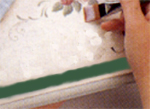| |
|
|
Read the full Varnishing
Guide
-
Before varnishing, check your project
completely - use a big brush to brush the surface completely
so that any dust particles are removed. If you have left
your project unvarnished for a long time, there may also
be grime on your surface. Wiping with a soft cloth will
usually work.
-
A good practise before varnishing
is to apply a coat of Clear Glazing Medium to your finished
work.
This
will give you
a very hard, durable surface upon which to apply
the varnish. It also protects your finished work.
- Slip-slap varnishing is a wonderful
way to give an "old world" look to your painted
projects. It gives a beautiful "burnished" matte
look to the finish. This is a technique that Jo Sonja has
taught in her
studio for the past several years. Mix Jo Sonja's water-based
varnish with Flow Medium in the ratio of 3 : 1. The Flow
Medium
is a "flattening agent", which, when added to paint
or varnish, causes the cell walls of the paint or varnish
to
dissolve, therefore, allowing the paint to flow, or spread
out onto the surface without ridges or clumps. Load your varnishing
brush with the mixture - only enough to fill the brush and
careful not to overload - and apply to your surface in "slip-slap",
criss-cross brush strokes. Work the varnish in to your project
working small areas at a time before reloading the brush.
Allow the surface to dry. Just takes a few minutes, and then
apply two more coats of varnish in the same manner, drying
well between each layer.

-
To repair "bubbly varnish" on
your project: be sure the varnish has completely dried on
your project. Tear off a
piece
of wet and dry 600 grit sandpaper, about 2" X 2" and
soak it in water with a few drops of dishwashing liquid, for
about 15 minutes. Dampen your project surface with the same
water. Placing the sand paper on the surface, put your index
and middle finger on the paper and very gently move the sandpaper
over the surface, until the surface is smooth.
The dishwashing liquid acts as a lubricant and the position
of your fingers prevents you from pressing too hard and going
through the old varnish to the painting. Let your surface dry
at least overnight, don't be impatient. Don't worry if you
see blotches on your project, it will disappear when you apply
the new layer of varnish. Thin the varnish with distilled water,
and apply one smooth coat.
That
may be
all
you need, or you can follow with more thinned coats.
- In cold weather, try not to wear woolen
(real or acrylic) clothing when you're varnishing. Bits of
fibre tend to find their way onto your project. You won't
be able to remove them once you're finished varnishing and
its quite frustrating.
|
|
|